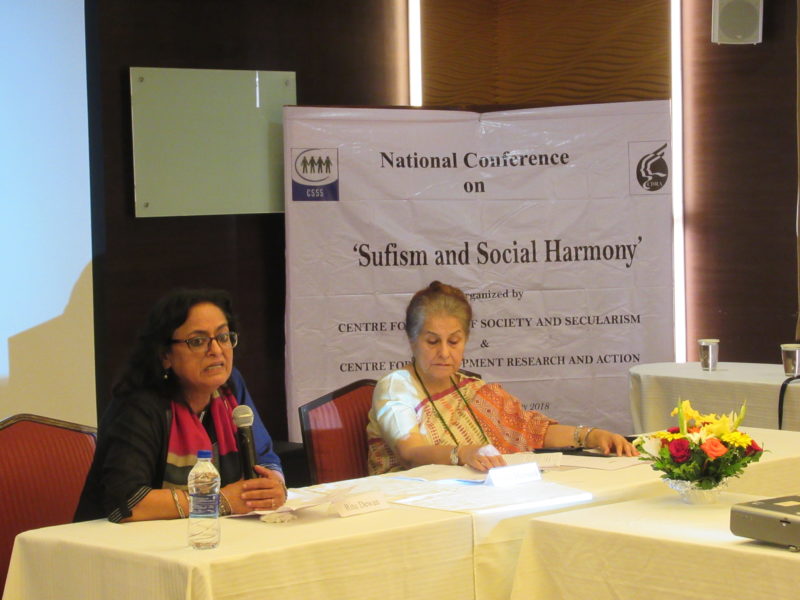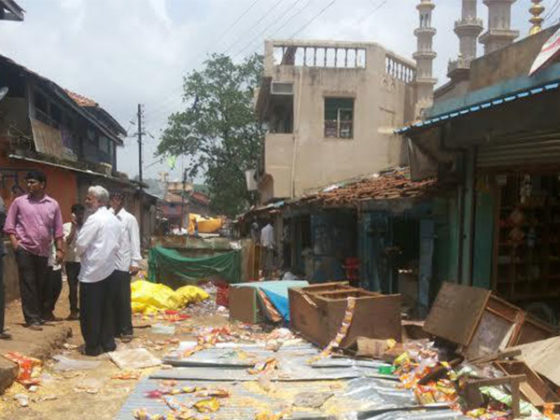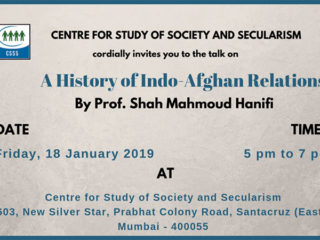“Sufi tradition can’t be viewed as an instrument or vehicle to some social end or social solution”, said eminent Carl Ernst. Prof. Carl Ernst was asked if Sufi tradition could counter global terrorism fuelling Islamophobia and if Sufism could represent a softer face of Islam. Resonating with other scholars, Ernst too pointed out to the complexity of such a premise and problematized Sufi school of thought.
Sufi thought was critically discussed in its various facets at a two day conference at Mumbai organized by Centre for Study of Society and Secularism on 22nd and 23rd February 2017.The conference sought to understand Sufism in all its complexity. The Sufi doctrines were discussed through the journeys, lives, anecdotes of celebrated Sufi figures in India; the thrust of the conference was on the interaction of Sufi thought with the other mystical traditions in India and the impact it had on social harmony and culture in India. What is perhaps most significant and relevant is that the conference discussed the challenges facing present day society and explored if Sufism offered any solutions to address them. In that regard the discussions were nuanced, multilayered and also went a long way in dispelling a rather naïve understanding of the scope and capacities of Sufism as a philosophy and tradition.
Dr. Syeeda Hameed very lucidly in her keynote address touched upon the rich journey of Sufism in India by revisiting Maulana Azad and Shaheed Sarmad. Maulana Azad who stood for composite nationalism and pluralism was greatly influenced by Sarmad. In the story of Sarmad lie the seeds of doctrines of Sufism- simplicity, humility and love. Sarmad was an Armenian Jew who came to India and became a tutor to Prince Dara Shikoh, son of the Mughal king Shahjahan and brother of Aurangzeb. Sarmad with his eclectic thoughts was perceived as a threat to the establishment. His critical thinking and simplicity (he used to roam the streets naked) posed a challenge to puritan and dogmatic Islam.
Dr. Hameed highlighted the doctrine of Wahadatul Wajood (oneness with God) and how the Sufis in India through their mysticism and devotion sought direct relation with God. The Sufis seek this unity with God and devote all their love to seek this union. She also quoted Rabia al Basri to build upon this idea. Rabia says,
If I adore You out of fear of Hell, burn me in Hell!
If I adore you out of desire for Paradise,
Lock me out of Paradise.
But if I adore you for Yourself alone,
Do not deny to me Your eternal beauty.
Thus God should not be sought out of fear or for want of favor/paradise but for love for the sake of love for the God alone. This spells the complete devotion for God and losing one’s identity to seek a higher truth and beauty in God.
Dr. Hameed while quoting the most celebrated Sufi in India, Moinuddin Chisti, explained what the highest form of devotion according to Chisti was-“Develop river like generosity, Sun like bounty and earth like hospitality”. Thus Sufism propounded a certain detachment from material world and serving to the needy. This idea was expanded by Prof. Ilina Sen who spoke about the Baul-Fakir tradition in West Bengal.The Bauls who follow the teachings of Lallan Fakir, a Muslim Sufi Saint, live in akharas and denounced family and private property. The Bauls believe in equality and reject barriers in the forms of caste, religion or gender. The tradition has followers both, Hindus and the Muslims, reflecting the syncretic culture of West Bengal. The tradition has been enriched from its interaction with the Bhakti movement. Ironically the puritans from both Hindu and Islamic traditions reject the Baul tradition terming it as heresy. The Sufi saints in Bengal, historically engaged with the marginalized like the peasants in undivided Bengal and thus had a large following in the rural areas. The Bauls express their ecstasy through songs and in this way have contributed significantly to the literature and music in Bengal.
The syncretic culture in India that is reflected in Baul tradition is blooming in other parts of India as well. In her very interestingly titled paper, “Needles that Darn, not Scissors that Cut- Two Sufi festivals in Delhi”, Rana Safvi, argues that Sufism is the needle that has woven the social fabric in India with inclusiveness and thus been a contributing factor in its harmony. She cites examples of two festivals in Delhi to elaborate- Basant celebrations in Hazrat Nizamuddin Auliya’s dargah and Phoolwaalo’n ki Sair in the Dargah of Qutbuddin Bakhtiyar Kaki.
Basant celebration in Auliya’s dargah has a beautiful story to go with it. To bring a smile on the lips of his grieving teacher, Nizamuddin Auliya, who had lost his nephew to a fatal illness, Amir Khusro dressed up in a yellow sari and sang a song he heard some women sing. The women were carrying mustard flowers and singing on the road near the Khwaja’s khanqah. The women told Khusro that they were going to the temple to offer these flowers to God and that would make God happy. In his pursuit to make his teacher smile, an inspired Khusro dressed up similarly and sang the same song to his teacher. Auliya finallysmiled when he recognized his favourite follower. Since then basant is celebrated at the Dargah wherenon-Muslims participate in large numbers. In an electrifying atmosphere the visitors don yellow and go in an ecstasy listening to the soulful qawwallis.
Similarly the festival of Phoolwallo ki Sairis celebrated in spirit of syncretic tradition. Mughal emperor Akhbar II and his queen Mumtaz Mahal offered a chaddar of flowers to Dargah of Hazrat Qutubuddin Bakhtiyar Kaki in Mehrauli after their beloved son was released by the British officials from prison. The Emperor, for whom all subjects were alike, also sent a floral offering to the ancient and nearby temple of Yogmaya Devi, the sister of Lord Krishna. Every year the Emperor ensured that he and his courtiers went to both, the Dargah and Mandir. If he could not go to the temple for some reason he would not go to the dargah either. The festival even today is celebrated with the same spirit. Similar traditions are existent in Rajasthan. Rose growers in Pushkar still send an offering (chaddar) of roses from the first harvest to Ajmer for the shrine of Ajmer dargah and Hindu musicians sing at the dargah as explained by Dr. Varsha Joshi.
In order to elaborate the harmonious exchange of traditions from different religions, Prof Jafri dwelled on the adaptations and more of an exchange in rituals and traditions which took place between the Chisti Sufis and other sections of the society. He pointed out that the Sufis contributed in development of some dialects into full fledged languages due to their use as vehicles for transmission of ideas. This led to writers producing some significant literature which mirrored social and political realities. The Chisti Sufis also adopted certain ritualistic traditions such as making sandal paste and ceremony of Gagar. This to some extent led to strengthening of a plural Awadhi culture.
Literature is an important component of Sufism and vice versa. The Mughal kings facilitated translations of important Hindu Sanskrit texts in Persian language. Prof. Shankar Nair cites the example of the translation of Laghuyogavashista by Nizam al-din Panipati. Though the translations are attributed to the liberal and tolerant attitudes of the Mughal kings, Prof. Nair argued that the Mughal interest in Sanskrit texts stemmed from their desire of gaining local Indian credentials and legitimacy. Also the rulers were looking for new models of local governance to consolidate their power. Sufi philosophy provided a conceptual framework to the rulers to understand such translations and thoughts. Panipati’s eclectic thoughts shouldn’t be misconstrued as aiming at religious conversions but so that the Hindus can be true to their own philosophy.
It is no wonder that given the richness of Sufi traditions and its influence on culture, Sufi music and festivals are becoming increasingly popular across the globe. According to Carl Ernst, due to globalization and rise in consumerism, there is a shift towards mass consumption, making Sufi thoughts more accessible in various forms like music and festivals, which may not be necessarily undesirable.
While revisiting the doctrines of Sufism and also its contribution to composite culture, the question that hung large was that if Sufism can counter the fundamentalism not just in Islam, but in other religions too. Sultan Shahin in his paper sounded a cautionary note on the wahabbization of Islam and increasing radicalization taking place amongst the youth. In such a scenario it is important to explore if Sufism can present a softer face of Islam. The responses to such fundamental questions at the best are complex as indicated by the discussions in the Conference.
As pointed out by Prof. Sana Aziz, Sufi Islam was contested by a more puritan form of Islam which the orthodoxy found as heretic. Thus there was a demand of reform in Islam. Her paper which dwelled on the historical context of Sufism explored the connection between reforms in Islam in the early 19th century and its seeds in Sufism. The paper argued that most of the reformist pioneers had strong Sufi antecedents and thus the binary of Sufism and reformism may be a fallacy. Sufism in this way impacted reforms in Islam as well. However Mehru Jaffer in her paper raises the point that Islamic history doesn’t take into account pre Islamic history and denies that tradition. This was vehemently challenged by other scholars who explained that Islam has incorporated traditions before Islam. Islam has validated the other prophets.
Although having had such a complex journey, what is the prominent discourse on Sufism in present day? Irfan Engineer narrated two incidents which may be instructive. One was about the institution of Pir in Bashirhat in West Bengal and other, the ban on the entry of women in the sanctum sanctorum at Haji Ali Dargah in MumbaiThe Haji Ali Dargah Trust argued that women can’t enter the sanctum sanctorum of the Dargah because women appear naked to the souls in the graveyard and hence they can’t visit the grave of any saint! The courts eventually settled in the favour of women’s entry into the sanctum sanctorum of the Dargah. Irfan Engineer argued that Sufi dargahs are losing their inclusive character and getting steeped into misogyny, hierarchy and conservatism. Sufi spaces were most inclusive transcending the barriers of caste, religion and gender. Khanqahs were spaces of inclusion. However the trusts entrusted with the care and management of Dargahs are leaning more towards orthodoxy and losing its radical and egalitarian character.
Similarly during a visit to Bashirhat in West Bengal which was also an epicenter of communal violence between Muslims and Hindus in 2017, Irfan Engineer described how the institution of Pir was become dynasty influenced. The Pir had a son who was using the influence and following of the Pir to gain support of the Muslim community and as means towards his own vested political ends. Instead of playing a role of peace building in times of conflict, the institution of Pir was being manipulated for political ambition which is a far call from the position of the most influential Sufi saints in India like Nizamuddin Auliya. This signals the decadence even in the Sufi tradition in India. The tradition is getting corrupted and misused for vested interests. Irfan Engineer ended on a note that, Sufism is too serious a business to be left to the Sufis. The Sufis alone don’t have a monopoly over the tradition and all progressive and liberals should reclaim this tradition and also look for other liberal traditions from non religious traditions too to ensure social harmony.
The trend mentioned above in dargahsand institutions related to Sufi has been in contrast to teaching of the most well known and celebrated Sufis in India and also what has been a cornerstone of Sufi philosophy. Nizamuddin Auliya maintained his distance from the State and power though there were other schools of thought in Sufism like Naqshbandi which were close to the State and thus enjoyed royal patronage. Nizamuddin believed that one can either serve the State or God. To him, it was important to bring happiness to a human heart. But in contemporary times, in contrary to teachings of Auliya, Sufi thought is being appropriated and in the pursuit of power in socio-political sphere.
Having considered the various dimensions, the contribution of Sufi thought to the composite culture and social harmony from a historical perspective cannot be undermined. It has shaped the social ethos and culture in so many aspects that its core can’t be ignored. It is a resource for social harmony. It is imperative to reiterate that what Sufism offers at large is a healing touch. In a multi cultural society like India which sadly has been witnessing manipulation of religious identities to polarize communities, Sufism offers the biggest value- love. As Rumi believed and taught that love is inclusive of all identities, since it embraces all. That is a valuable lesson for us in conflict ridden societies of present times.




